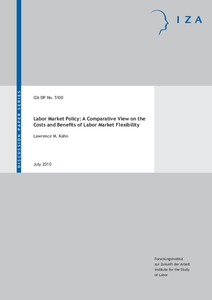Labor market policy: a comparative view on the costs and benefits of labor market flexibility
"I review theories and evidence on wage-setting institutions and labor market policies in an international comparative context. These include collective bargaining, minimum wages, employment protection laws, unemployment insurance (UI), mandated parental leave, and active labor market policies...
| Main Author: | |
|---|---|
| Institution: | ETUI-European Trade Union Institute |
| Format: | TEXT |
| Language: | English |
| Published: |
Bonn
2010
IZA |
| Subjects: | |
| Online Access: | https://www.labourline.org/KENTIKA-19184117124919023999-Labor-market-policy-a-comparat.htm |
| _version_ | 1771659897257066498 |
|---|---|
| author | Kahn, Lawrence M. |
| author_facet | Kahn, Lawrence M. |
| collection | Library items |
| description | "I review theories and evidence on wage-setting institutions and labor market policies in an international comparative context. These include collective bargaining, minimum wages, employment protection laws, unemployment insurance (UI), mandated parental leave, and active labor market policies (ALMPs). Since it is unlikely that an unregulated private sector would provide the income insurance these institutions do, these policies may enhance economic efficiency. However, to the extent that unemployment or resource misallocation results from such measures, these efficiency gains may be offset. Overall, Scandinavia and Central Europe follow distinctively more interventionist policies than the English speaking countries in the Northern Hemisphere. Possible explanations for such differences include vulnerability to external market forces and ethnic homogeneity. I then review evidence on the impacts of these policies and institutions. While the interventionist model appears to cause lower levels of wage inequality and high levels of job security to incumbent workers, it also in some cases leads to the relegation of new entrants (disproportionately women, youth and immigrants) as well as the less skilled to temporary jobs or unemployment. Making labor markets more flexible could bring these groups into the regular labor market to a greater extent, at the expense of higher levels of economic insecurity for incumbents and higher levels of wage inequality. The Danish model of loosening employment protections while providing relatively generous UI benefits with strict job search requirements holds out the possibility of reducing barriers for new entrants and the less skilled while maintaining some level of income insurance. " |
| format | TEXT |
| geographic | OECD countries |
| id | 19184117124919023999_43348fbc3bce4f6484b89090a4a4df3e |
| institution | ETUI-European Trade Union Institute |
| is_hierarchy_id | 19184117124919023999_43348fbc3bce4f6484b89090a4a4df3e |
| is_hierarchy_title | Labor market policy: a comparative view on the costs and benefits of labor market flexibility |
| language | English |
| physical | 33 p. Digital |
| publishDate | 2010 |
| publisher | Bonn IZA |
| spellingShingle | Kahn, Lawrence M. employment security statistics wage determination labour market policy Labor market policy: a comparative view on the costs and benefits of labor market flexibility |
| thumbnail | https://www.labourline.org/Image_prev.jpg?Archive=115504693378 |
| title | Labor market policy: a comparative view on the costs and benefits of labor market flexibility |
| topic | employment security statistics wage determination labour market policy |
| url | https://www.labourline.org/KENTIKA-19184117124919023999-Labor-market-policy-a-comparat.htm |

